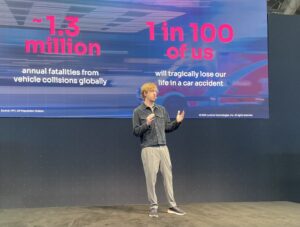
Luminar presents Automatic Emergency Steering at CES
By onAnnouncements | Technology
Luminar Founder and CEO Austin Russell debuted Automatic Emergency Steering (AES) using the new Iris+LiDAR sensor with an audience at the Consumer Technology Association Conference (CES) in Las Vegas Tuesday.
The company showed how a Luminar-equipped vehicle could swerve around a pedestrian dummy crossing its path on a demonstration track. The vehicle could then immediately deploy automatic emergency braking (AEB) when it came across a tire lying in the roadway. AEB traditionally has difficulty detecting dark objects like tires because of little light reflection.
Russell said Luminar’s AES can decide within less than a second during daytime and nighttime conditions.
“At the end of the day having a last-second reaction time, even if you’re not distracted, is still a very, very challenging task for any human,” Russell told an audience Tuesday.
Luminar’s Iris+ laser can detect dark objects at night up to 300 meters away and up to 300 points per square degree, according to the company’s website.
The AES will still need to go through third-party testing before it can be used in production, according to The Verge.
Russell also unveiled a concept F1 Mercedes-Benz Safety Car equipped with Luminar technology during the conference.
“We are now working with Mercedes AMG to be able to build the world’s safest safety car for Formula One,” Russell said. “We’re bringing this kind of technology out from the road — the same technology going in Mercedes vehicles — out onto the track.”
In February, Mercedes and Luminar announced a partnership to use the technology in some of the OEM’s next-generation vehicles.
Polestar 3 vehicles will also be equipped with Luminar by the end of the year, and the technology will be included in Polestar 4.
Luminar also met its first major Run at Rate Production test for Volvo Cars as a precursor to the launch of the Volvo EX90, according to a press release.
The company has designed and manufactured six chips across receiver, laser, and processor since the formation of its semiconductor in 2023.
Russell said the company has decided to focus on safety features instead of diving into the fully autonomous driving sector.
“We always start with the problem, what are we ultimately solving for here? And it all comes back down to the implications of vehicle accidents,” Russell said. “…the reality is that the camera and radar-based systems out there are not able to solve for the majority of these kinds of vehicle-related collisions.”
A step change in lidar technology and capabilities is still needed to make vehicles safer, he said.
Russell said fully autonomous vehicles have many problems to solve, but advancements in safety features happen sooner.
“We’re able to give the driver almost superhuman-like capabilities to avoid accidents, to take over the system, when it senses that you’re going to get into a critical or potentially life-changing scenario,” Russell said.
Fewer accidents will directly translate into fewer insurance claims, Russell said. This could lead to a lower cost of insurance, he said.
However, studies have found purchasing vehicle’s with safety features can cost thousands more and repairing damaged safety equipment can be costly.
Luminar is also working with Swiss Re to study safety features on consumer and commercial vehicles. Russell said findings from the study will be released this year.
Images
Featured image: Luminar CEO and Founder Austin Russell speaks during CES 2024. (Teresa Moss/Repairer Driven News)
Mercedes-Benz safety car. (Courtesy of Luminar)
Luminar CEO and Founder Austin Russell and Mercedes-Benz Chief Technology Officer unveil a concept Mercedes-Benz F1 Safety Car. (Teresa Moss/Repairer Driven News)


